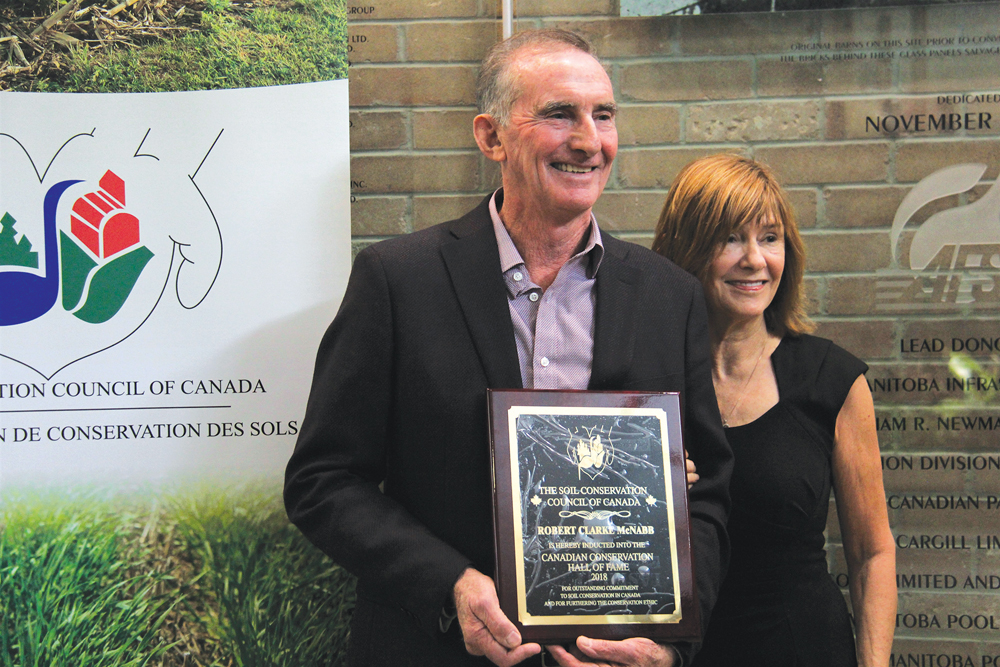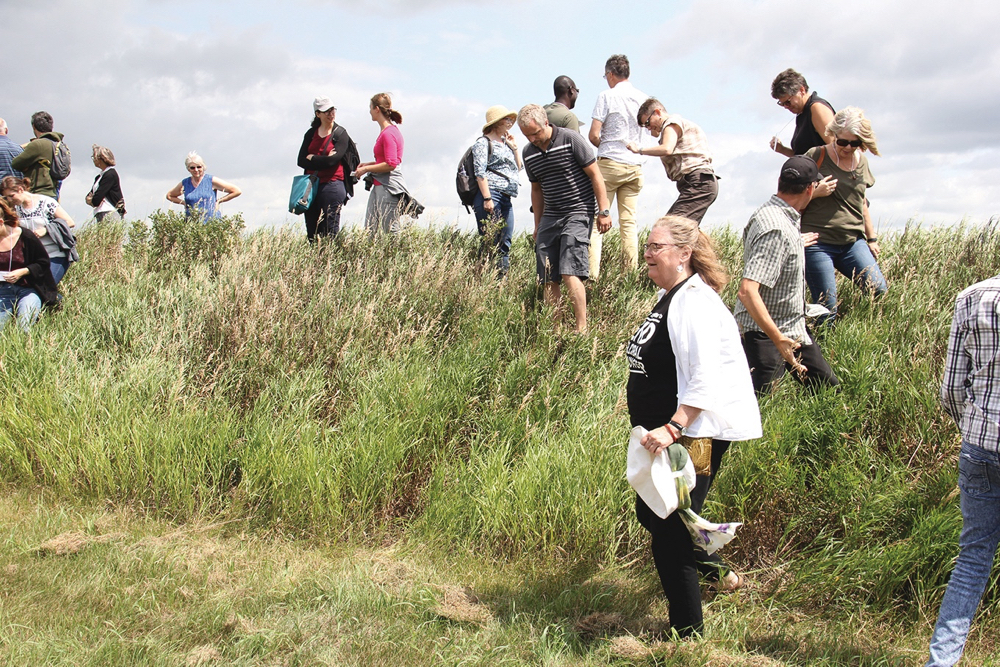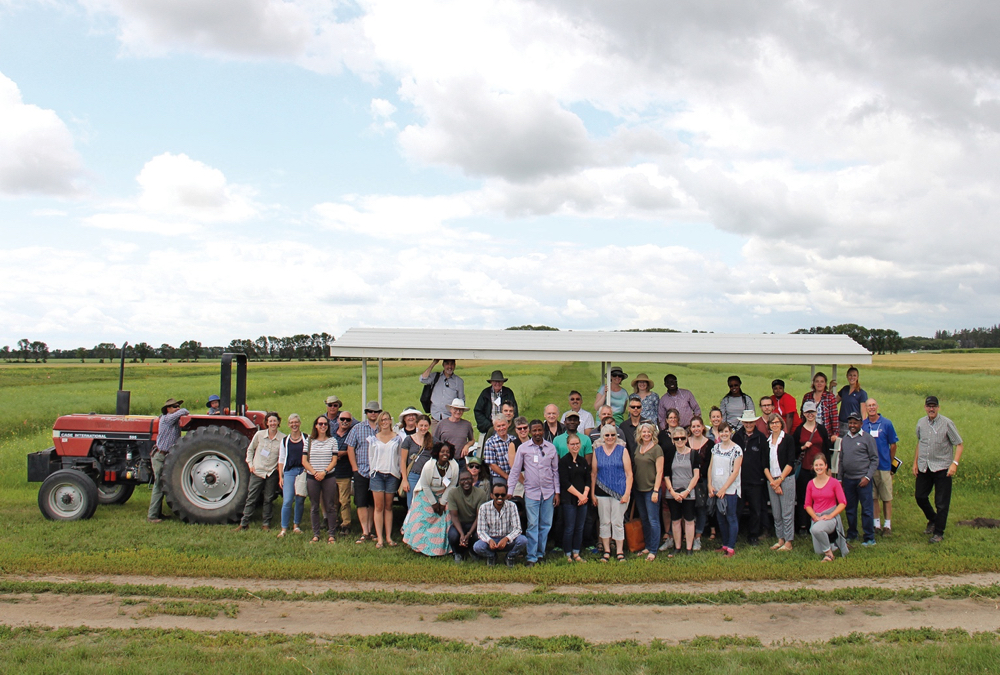Newdale’s name is officially a “dirt-y” word and those living and farming here are proud of it.
This past weekend local farm families and townsfolk unveiled a large sign on its Main Street showing how their community shares its name with the province’s official soil.
The celebration comes precisely seven years to the day since Manitoba gave royal assent and declared Newdale Clay Loam its provincial soil on June 17, 2010.
Three large signs, including one on the village’s Main Street, depict Newdale soil’s colourful layers, explain how this soil formed over thousands of years, and describe the soil type’s characteristics. The signs also tell some of the story of Newdale itself, with a yesteryear photo of its Main Street and historical information about its settlement and ties to that soil.
Read Also

Know where and why yields are low in your fields
Managing soil health issues can help farmers build back yield in unproductive patches of the field.
“This recognition is about community as much as it is about the soil itself,” said provincial Minister of Agriculture Ralph Eichler who congratulated the community for its work to raise the profile of both a rural community and the provincial soil.
“You take great pride in this. I would like to commend the community of Newdale for its support and excitement in promoting the importance of our provincial soil.”
Talk in Newdale began almost immediately after 2010 that their town should find a way to link their name to the provincial soil and use it as a way to educate the public about soil, said local farmer Bruce Dalgarno.
“We wanted something that people driving by could look at, and could easily understand how this soil was formed over the last 10,000 years and could relate to why this is the official soil,” said Dalgarno, who began to champion the idea in earnest in 2015, which the United Nations declared International Year of the Soil.
A local committee was formed and worked with provincial soil scientists, about $12,500 funds were raised and the signs made, culminating in a celebration here this past Saturday.
Among the numerous soil scientists and visiting dignitaries in Newdale last weekend was Elaine Gauer, land use specialist with Manitoba Agriculture and a past president of the Manitoba Soil Scientists Society (MSSS). She’s widely credited among colleagues for getting the ball rolling years ago towards declaring a provincial soil declaration.

Gauer said she was delighted to see Newdale do this. They found a way to tell both their own story while teaching more people about importance of soil, she said.
“Soils in general are important to the Manitoba Soil Science Society, of course, but to actually have the whole community behind it and to acknowledge it is just wonderful,” she said.
It was the ear of Cliff Cullen (PC-Spruce Woods), now minister of growth enterprise and trade, that Gauer first bent about declaring a provincial soil some years back. Cullen was also in Newdale last weekend and described some of the political machinations his private member’s bill had to go through before the province would agree to go forward.
“We had to work at it but we did get it done,” he said, noting the bill even died on the order paper in 2008. Two years and much more discussion later, it was given royal assent.
Newdale Clay Loam was chosen after sifting through a huge selection of hundreds of types of soils in Manitoba, explained Curtis Cavers, a Portage la Prairie-based agrologist with Agriculture Canada who also spoke in Newdale.
“We selected that soil out of more than 550 soil types or soil series in Manitoba,” he said, jokingly adding, “fortunately it didn’t come to fisticuffs.”
‘We’ included the members of the Manitoba Soil Science Society (MSSS), this year marking its 60th anniversary. They had a lively debate about it but always felt it ultimately didn’t matter which one it would ultimately be, he said.

The whole point was to raise the profile of all soils and educate the public about their importance, Cavers said.
“We wanted to pick one that was reasonably representative of all the soils in Manitoba so we could compare and contrast with a reference point. It would be a very effective tool to teach and show people that not all soils are the same.
“If we can show that soils are variable, then we can show people why they are different and why we need to take steps to manage them,” he added.
Newdale soil ultimately topped the charts by consensus within the MSSS and was put forward as the one for proclamation. Its black topsoil, unique relative to other soils of the Prairies or parts of Canada, was one characteristic that made it stand out, Cavers said. Others were its visible soil layers and good productivity.
“And it was found in a landscape that’s similar to many other areas of Manitoba… all of which help us demonstrate and communicate the need for proper management and protection of soil,” he said.
John Heard, soil fertility specialist with Manitoba Agriculture, who’s had some fun festooning the Newdale soil monolith with a sash and likening it to a beauty queen, said many states and Canadian provinces with designated provincial soils haven’t necessarily selected “the best or most productive soil” for proclamation. But they’ve always chosen one that has a good story that goes with it.
“Certainly the Newdale soil does that,” said Heard. “It’s characteristic of a lot of the soils in the uplands. And when you compare it to the other soils in Canada it’s a very colourful and a very productive soil.”
Soil study tours, posters about Newdale soil, plaques and even soil jewelry made by members of the MSSS are now helping to spread the word and tell that story.
Newdale soil covers some 1.3 million acres in Manitoba and typifies the type of soil farmed across much of western Manitoba. It developed under grasslands over tens of thousands of years, after glaciers, acting like a giant blender, ground together granite, limestone and shale, and another 12,000 years of Prairie grass growth laid down its characteristic black top layer.
It was given the name ‘Newdale’ during the reconnaissance soil survey of the 1950s when soil scientists, classifying soil types throughout the province, named them after nearby communities they were being collected from.
Today some soils in Manitoba bear names of places that no longer exist.
Newdale’s new sign’s dramatic black and white photo is of a much larger village at the turn of the last century. It also includes a brief history of how the village was founded — in 1878 as a trading post along the Fort Ellice Trail.
The other signage will be erected on Hwy. 16 later this month.
Next week: Part 2 — How Newdale soil was named: A look back at the provincial soil survey




















